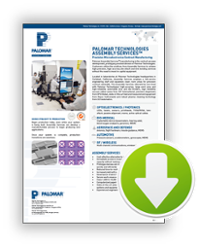February 4th marks “National Go Red Day” in efforts to raise awareness of heart disease in the US. The statistics of Americans—primarily women—affected by heart disease is staggering and reminds the Palomar Technologies teams how our dedication to developing processes and applications for reliable and biocompatible medical devices, such as those for cardiac care, is more important than ever.
Biocompatibility refers to how well a material coexists within the biological equilibrium of the human body’s systems. The excellent biocompatibility of platinum, combined with its good stimulation and sensing properties, makes this precious metal a top choice for use in life-saving cardiovascular implants such as defibrillators and pacemaker electrodes.
Platinum is a dense and malleable metal and is one of the most rare elements in the Earth's crust. It is generally un-reactive and exhibits remarkable resistance to corrosion—even at high temperatures—and is considered a noble metal. Because only a few hundred tons are produced annually, platinum is a scarce material, highly valuable and precious metal commodity.
Wire Bonding Platinum (Pt) versus Wire Bonding Gold (Au)
Historically, platinum has been more expensive than gold primarily due to its rarity and desirability as an investment metal (large market/small supply). However, in recent years the increased price of gold has approached the price of platinum. Although, at the time of this writing, platinum is still approximately 30% more expensive than gold, making cost a relatively significant factor in its selection as a material for interconnecting microelectronic circuits.
A significant physical characteristic of platinum is its lower electron-mobility compared to gold. In other words, platinum is a harder material than gold, and it further work-hardens during the process of thermosonic wire bonding, exacerbating the problem of the materials hardness and making it a more difficult material to wire bond than the softer gold.
Thermosonic wire bonding is a well-known process which combines heat, ultrasonic energy and force to bond small wires, typically on the order of one or two thousandths of an inch in diameter and on the order of hundreds of thousandths of an inch in lengths. These wires complete an electrical path from a metalized surface on a microchip to another metalized surface on the substrate of the circuit. Bonding occurs through the process of atomic diffusion.
Atomic diffusion—commonly referred to simply as diffusion—is a process in which the random thermally activated movement of atoms in a solid result in the net transport of atoms. In the case of wire bonding, diffusion occurs in monometallic systems such as Pt/Pt and Au/Au or in a bi-metallic system such as Pt/Au.
When bonding platinum wire, ultrasonic power settings of the wire bonding machine, which are appropriate for gold wire, can cause the harder platinum wire to damage the underlying semiconductor material beneath the bonding pad—an effect called “cratering”. Therefore, ultrasonic power is reduced when bonding platinum.
Platinum also requires higher bonding temperatures, whereas gold is typically thermosonically bonded at approximately 150 degrees Celsius. Bonding platinum wire requires twice the heat as gold at ~300 degrees Celsius. Fine wires with diameters between 1 and 2 mils, for example, can be successfully bonded using thermosonic ball bonding equipment. However, the higher process temperature required might limit its application due to other materials within the circuit or device that may not be able to withstand the extreme temperature during bonding.
Summary
The selection of platinum over gold for a given microelectronic wire bonding application is based on several factors:
- The application must require the benefits of platinum’s properties such as excellent biocompatibility hardness and stiffness
- It must be able to support the increase in material cost
- It must be able to withstand the increase in bonding temperature and the increased potential for damage to the microchip known as “cratering”
The Palomar Technologies 8000i Wire Bonder is currently in use by implantable medical device manufacturers around the globe. The precision microelectronics Assembly Services (“Assembly Services”) division of Palomar Technologies offers a wide range of contract packaging solutions, including platinum wire bonding processes.
Learn More About Precision Microelectronics Assembly Services
----Steven Buerki